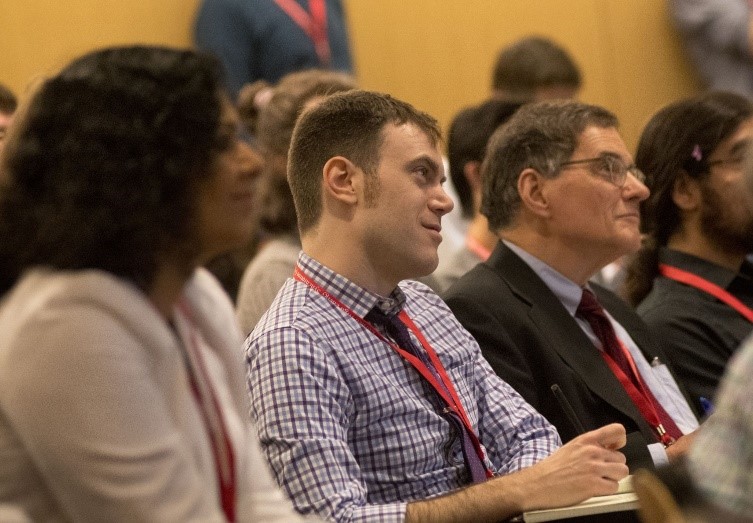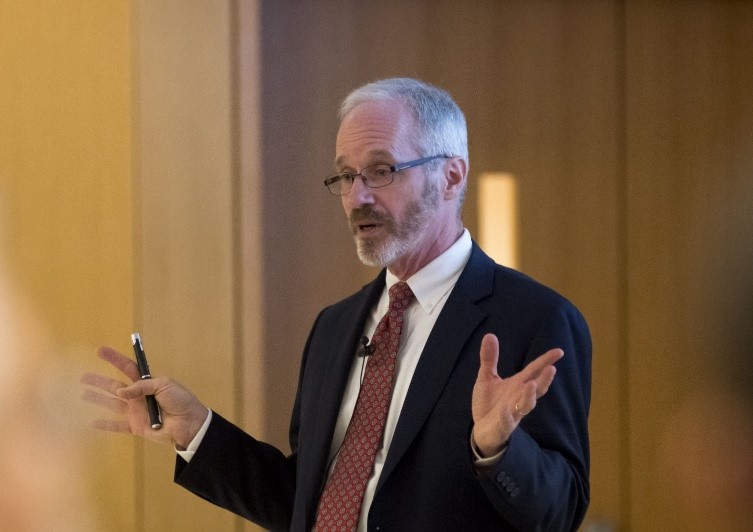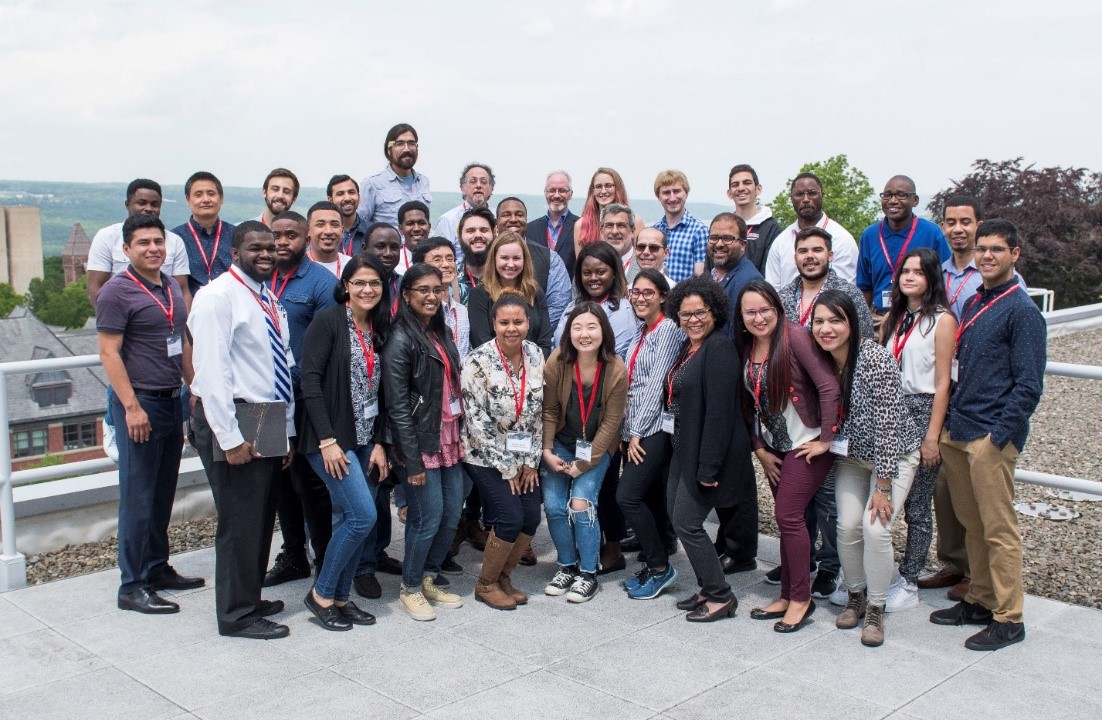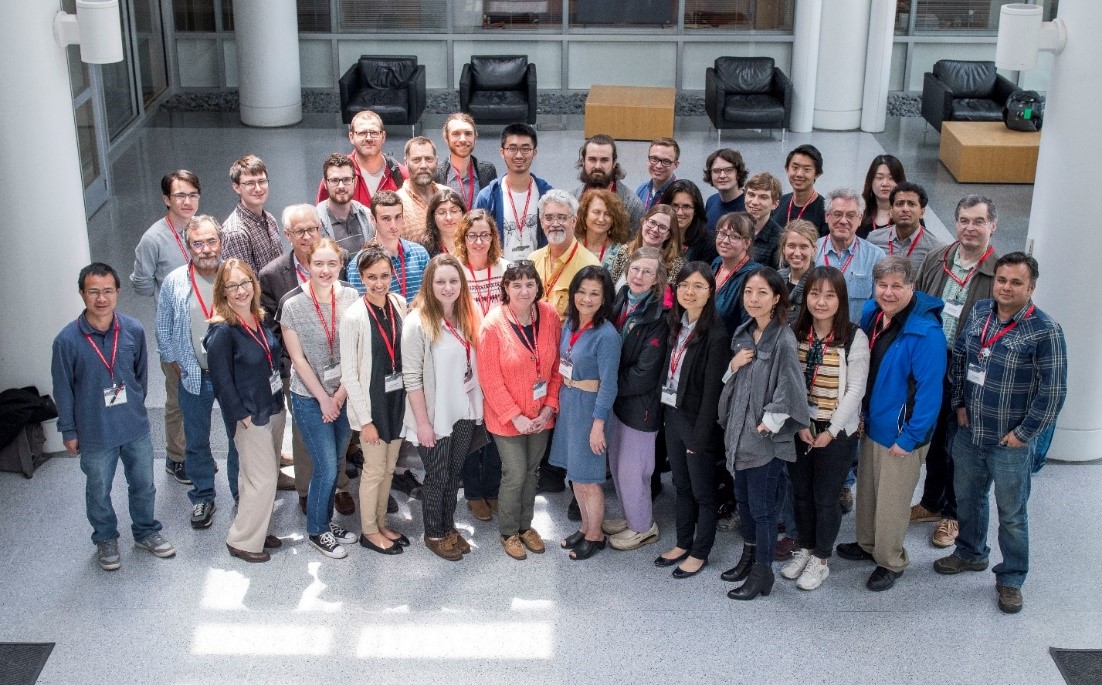2019 CHESS Users Meeting and Workshops
Meeting Reports
On June 4th, 2019, exactly one year to the day after the Cornell High Energy Synchrotron Source (CHESS) shut down for the CHESS-U upgrade project, the CHESS Users' Meeting attracted a record number of 225 registered participants to the Cornell campus to look back at major milestones of the project and to discuss X-ray science enabled by the ambitious upgrade.
CHESS Director Prof. Joel Brock started the meeting by reviewing the upgrade of the facility that, over 12 short months, transformed CHESS into a world-leading high flux, high energy X-ray facility. He explained that the main objectives of the upgrade, which involved reconfiguring the magnet structure of one-sixth of the storage ring and operating with a single positron beam instead of counter-rotating electron and positron beams, eliminated many of the previous performance limitations. Moreover, increasing the storage ring energy from 5.3 GeV to 6 GeV and ring current from 100 mA to 200 mA combined with new insertion devices and state-of-the-art beamlines enables high performance X-ray diffraction, imaging, and spectroscopy studies at CHESS not previously possible. Prof. Brock also highlighted CHESS' transition from stewardship by the National Science Foundation (NSF) to a partner funding model, where NSF, the Air Force Research Laboratory (AFRL), and the National Institute of Health (NIH) each support several beamlines. Following Prof. Brock's introduction, accelerator physicist James Shanks reviewed technical aspects of the storage ring upgrade and the resulting performance improvements. Shanks emphasized that at the time of the users meeting X-rays had already been delivered to three new beamlines and that beamline commissioning was well underway.
NSF program director Guebre Tessema introduced the Center for High Energy X-ray Studies (CHEXS), the new NSF-funded center at CHESS, and subsequent talks by CHESS scientists and postdocs laid out the capabilities of the new CHEXS beamlines: Jacob Ruff covered the Q-Mapping for Quantum Materials (<QM>2) beamline, Ken Finkelstein described the Photon-in Photon-out X-ray Spectroscopy (PIPOXS) beamline, Kelly Nygren discussed the Forming and Shaping Technology (FAST) beamline, and the High Pressure Biology (HPBio) beamline optimized for SAXS measurement and jointly supported by NSF and NIH was presented by Richard Gillilan. MacCHESS director Marian Szebenyi introduced the Flexible Crystallography beamline (FlexX), also jointly operated by NIH and NSF, which enables standard macromolecular crystallography (MX) as well as novel approaches to MX at CHESS. Paul Shade (AFRL) led the discussion of the AFRL-funded Materials Science Network at Cornell (MSN-C) focusing on structural materials characterization (Structural Materials Beamline, SMB) and functional materials analysis (Functional Materials Beamline, FMB).
Presentations in the afternoon showcased recent research at CHESS and outlined new scientific directions enabled by the CHESS upgrade. Ryan Martinie (Princeton University), the winner of the student paper prize, described his use of X-ray emission spectroscopy at CHESS to study the structural nuances of metalloenzyme intermediates. Michael Thompson (UC San Francisco) discussed how he employed macromolecular crystallography for identifying dynamic structural changes within enzymes. Richard Robinson (Cornell) showed his group's recent work using X-ray emission spectroscopy and diffuse scattering to determine the structure, site occupations, and charge hopping properties of nanoscale materials. Next, Hilmar Koerner (AFRL) covered the importance of composite materials for aerospace applications and his plan to monitor 3D printing processes in situ using X-ray techniques at CHESS. Thien Phan (NIST) concluded the session discussing how X-ray scattering techniques can be used in situ to assess residual strain in additive manufactured materials.
A poster session provided ample opportunity to "talk shop" and tours of the CHESS experimental floor gave the attendees a first look at the new CHESS experimental area and the new beamlines. The day concluded with a reception and dinner at the Statler Hotel. Poster prizes were awarded to William Thomas, Cornell University, for scientific achievement and to Divya Gadkari, Cornell University, for technical achievement. Lastly, Professor Johnathon Lunine (Department of Astronomy, Cornell) presented an intriguing after dinner talk on the search for life within our solar system, especially on Saturn's moon, Enceladus.
Two workshops were held in conjunction with the CHESS User's Meeting. The "Synchrotron Essentials" Workshop was tailored to introduce graduate students and new users to the capabilities available at synchrotron sources such as CHESS. In collaboration with the Partnerships for Research and Education in Materials (PREM) and Interdisciplinary Consortium for Research and Education Access in Science and Engineering (INCREASE) programs, CHESS was able to financially support 24 students from 14 institutes to attend the Users' Meeting and the "Synchrotron Essentials" Workshop, providing access for students who may not have otherwise been able to attend. For participants who could not travel to Cornell, the morning session of the workshop was streamed online via YouTube Live.
The workshop opened with a lecture covering the basics of X-rays, synchrotron sources, and beamlines given by CHESS Associate Director Elke Arenholz. Participants were introduced to scattering and spectroscopic methods as well as research questions these techniques typically address in talks presented by Kelly Nygren (CHESS) and Chris Pollock (CHESS), respectively. Since the goal of the workshop was to introduce participants to synchrotron methods and guide them to becoming new users, Ernie Fontes (Cornell Laboratory for Accelerator-based Sciences and Education) led a tutorial on how to write effective beamtime proposals and answered the common questions concerning the proposal process. The morning concluded with a lecture by PREM principal investigator Carlos Cabrera (University of Puerto Rico, Río Piedras) on electrocatalytic reactions and how synchrotron methods can be used to study these processes. In the afternoon, workshop attendees participated in tours of the CHESS experimental floor lead by CHESS scientists and postdocs. Lively discussion among students, postdocs, and scientists connected the concepts reviewed in the morning to experiments employing unique CHESS facilities. The day closed with a BBQ and guided hike at a nearby state park.
The second CHESS Users' Meeting workshop focused on "Biomolecules Under Pressure" and was co-organized by Richard Gillilan (CHESS), Durgesh Rai (CHESS) and Sol Gruner (Cornell). It focused on the importance of high pressures (HP) for the evolution of life, macromolecular architectures, astrobiology, food science, as well as the understanding of enzyme function. The workshop also showcased the opportunities of X-ray techniques for HP science to its 54 attendees from 18 institutions from across the United States, as well as France, Italy and Hungary.
After introductory remarks by Richard Gillilan, Cathy Royer (Rensselaer Polytechnic Institute) discussed the use of HP methods to probe sequence determinants of folding cooperativity by pressure-based mapping of protein conformational landscapes. Royer emphasized that pressure is an excellent thermodynamic "knob" that can be used to explore the energetic landscapes of biological macromolecules. Susana Teixeira (NIST Center for Neutron Research and University of Delaware) gave an overview of instrumentation for HP small angle neutron scattering (HP-SANS) experiments at NIST and her group's recent HP-SANS results of piezophiles, i.e., organisms that thrive under pressure. Karyn Rogers (Rensselaer Polytechnic Institute) followed with a talk on "Living the High Pressure Life" emphasizing the prevalence of HP life on Earth. Rogers laid out fascinating ideas about how life may have evolved using studies on metal clusters in minerals, catalytic aspects of which may be preserved in the active sites of metalloproteins. Bing Yan (Cornell) covered in his talk how the food industry utilizes HP to sterilize and process food. Because this is possible at comparatively low temperatures, flavors and nutrients typically lost during pasteurization can be preserved. Richard Gillilan and Durgesh Rai described in their presentations the CHESS beamlines optimized for bioscience including HP-crystallography, HP-SAXS and HP-SEC-SAXS facilities. Workshop participants had the opportunity to take a tour of CHESS including beamlines optimized for the characterization of structural materials, soft matter, quantum materials as well as biological systems. The attendees got a first look at the HP-SAXS experiments as well as a specialized diamond anvil cell optimized for macromolecular crystallography. The workshop concluded with a brief presentation on the fundamentals of SAXS, SAXS instrumentation, software integration as well as computational methods for extraction of structural information.
In summary, the 2019 CHESS Users' Meeting was an exciting opportunity to learn more about the recent upgrade of the facility, to discuss its new experimental capabilities, and to plan for experiments at CHESS when it resumes user operation in October 2019.





